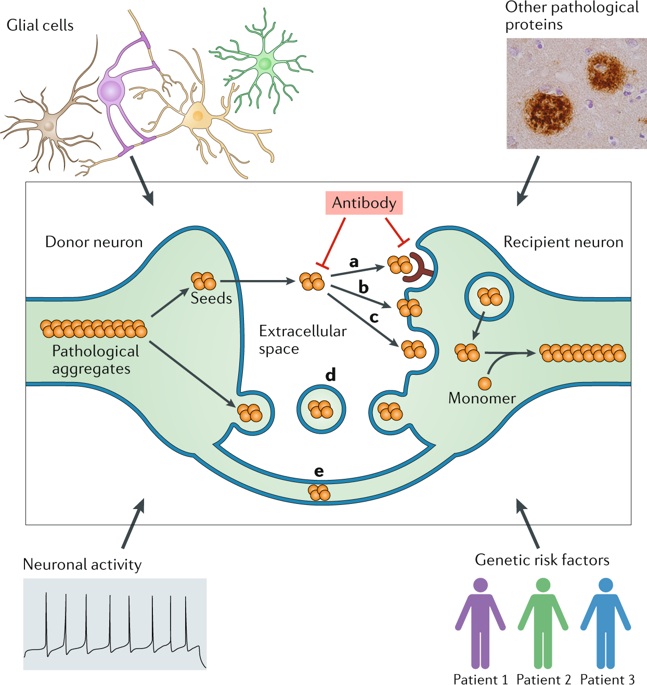当前位置:
X-MOL 学术
›
Nat. Rev. Neurol.
›
论文详情
Our official English website, www.x-mol.net, welcomes your
feedback! (Note: you will need to create a separate account there.)
Protein transmission in neurodegenerative disease.
Nature Reviews Neurology ( IF 28.2 ) Pub Date : 2020-03-23 , DOI: 10.1038/s41582-020-0333-7 Chao Peng 1 , John Q Trojanowski 2 , Virginia M-Y Lee 2
Nature Reviews Neurology ( IF 28.2 ) Pub Date : 2020-03-23 , DOI: 10.1038/s41582-020-0333-7 Chao Peng 1 , John Q Trojanowski 2 , Virginia M-Y Lee 2
Affiliation

|
Most neurodegenerative diseases are characterized by the intracellular or extracellular aggregation of misfolded proteins such as amyloid-β and tau in Alzheimer disease, α-synuclein in Parkinson disease, and TAR DNA-binding protein 43 in amyotrophic lateral sclerosis. Accumulating evidence from both human studies and disease models indicates that intercellular transmission and the subsequent templated amplification of these misfolded proteins are involved in the onset and progression of various neurodegenerative diseases. The misfolded proteins that are transferred between cells are referred to as 'pathological seeds'. Recent studies have made exciting progress in identifying the characteristics of different pathological seeds, particularly those isolated from diseased brains. Advances have also been made in our understanding of the molecular mechanisms that regulate the transmission process, and the influence of the host cell on the conformation and properties of pathological seeds. The aim of this Review is to summarize our current knowledge of the cell-to-cell transmission of pathological proteins and to identify key questions for future investigation.
中文翻译:

神经退行性疾病中的蛋白质传递。
大多数神经退行性疾病的特征是错误折叠的蛋白质在细胞内或细胞外聚集,例如阿尔茨海默病中的淀粉样蛋白-β 和 tau、帕金森病中的 α-突触核蛋白和肌萎缩侧索硬化症中的 TAR DNA 结合蛋白 43。来自人类研究和疾病模型的越来越多的证据表明,细胞间传递和随后这些错误折叠蛋白的模板化扩增与各种神经退行性疾病的发病和进展有关。在细胞之间转移的错误折叠的蛋白质被称为“病态种子”。最近的研究在识别不同病理种子的特征方面取得了令人兴奋的进展,特别是那些从患病大脑中分离出来的种子。我们对调节传播过程的分子机制以及宿主细胞对病态种子构象和性质的影响的理解也取得了进展。本综述的目的是总结我们目前对病理蛋白的细胞间传播的了解,并确定未来研究的关键问题。
更新日期:2020-03-23
中文翻译:

神经退行性疾病中的蛋白质传递。
大多数神经退行性疾病的特征是错误折叠的蛋白质在细胞内或细胞外聚集,例如阿尔茨海默病中的淀粉样蛋白-β 和 tau、帕金森病中的 α-突触核蛋白和肌萎缩侧索硬化症中的 TAR DNA 结合蛋白 43。来自人类研究和疾病模型的越来越多的证据表明,细胞间传递和随后这些错误折叠蛋白的模板化扩增与各种神经退行性疾病的发病和进展有关。在细胞之间转移的错误折叠的蛋白质被称为“病态种子”。最近的研究在识别不同病理种子的特征方面取得了令人兴奋的进展,特别是那些从患病大脑中分离出来的种子。我们对调节传播过程的分子机制以及宿主细胞对病态种子构象和性质的影响的理解也取得了进展。本综述的目的是总结我们目前对病理蛋白的细胞间传播的了解,并确定未来研究的关键问题。











































 京公网安备 11010802027423号
京公网安备 11010802027423号